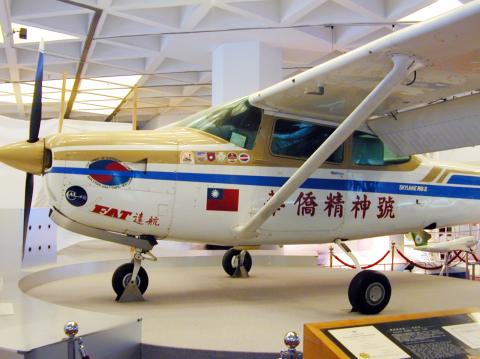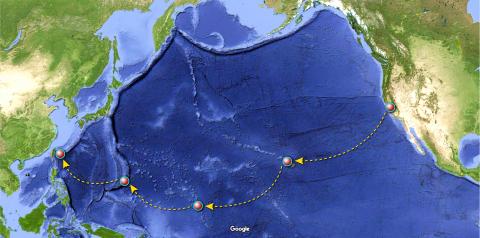Taiwan in Time: July 18 to July 24
In early July of 1984, Jerry Tsai (蔡雲輔) found himself temporarily stranded on Saipan in the Northern Mariana Islands. His problem-riddled bid to become the first person to cross the Pacific in a small single-engine plane (under 1,750kg) suffered another mishap when the tires of his Cessna 182RG blew out while landing, damaging its nose and propeller.
But Tsai vowed not to give up. It took three weeks to fix his plane, and he set out on the last leg of his journey of about 13,500km. His destination: Taiwan.

Photo: Luo Cheng-ming, Taipei Times
Not much is known about Tsai’s early life, except that he had lived in San Francisco for decades by the time of his journey. A former boxing champion, Tsai had sailed solo to the Caribbean and also held a diving license.
Referring to himself as an “adventurer,” Tsai discusses his life philosophy with Taiwanese writer Yu Li-ching (喻麗清) in her book, Follow the Green Line (沿著綠線走).
“Compared to the freedom of flying, what is there to fear about death?” he says. “I believe that this is not limited to physical flight. It can be the flight of thought, or flight of the soul.”

Courtesy of Google Maps
This was back when it was not politically acceptable to distinguish Taiwanese and Chinese, thus there is no clear indication of Tsai’s origin of birth. US newspapers either referred to him as American or Chinese-American, but he seemed to resent the racial discrimination against Asians in the US and clearly had something to prove.
Nevertheless, Tsai’s journey was seen as a source of pride for the people and government of Taiwan back then, and he said that wanted to accomplish this feat for the glory of the “motherland.”
Tsai’s tells his story in a first-person account in Biographies of Overseas Chinese (世界華僑名人傳), edited by Yang Ching-nan (楊慶南).
On June 18, 1984, Tsai announced to the world his plans to depart from San Francisco for Taipei in the Cessna named Spirit of Overseas Chinese (華僑精神號), making stops in Honolulu, Majuro and Saipan. During his test run from San Francisco to San Diego, he broke the world record for speed over a recognized course for planes between 1,000kg and 1750kg — which has been superseded since.
As Tsai was waiting to depart, he recalled hearing over the VHF radio other pilots’ disbelief about him trying to fly such a tiny aircraft across the Pacific.
“Over the past year, everybody has called me crazy — even my wife,” he writes.
Yang writes in the commentary on Tsai’s voyage about how dangerous the flight was: “This type of single engine small plane is very easily affected by the climate. It also carries limited fuel, and if blown off course, might not have enough to reach its destination. Small aircraft are also not well-adapted for turbulence and storms. Also, the altitude limitations of these aircraft make communication more difficult, and the small plane body can only carry limited emergency equipment.”
Yang adds that this flight definitely would not have been sanctioned in Taiwan, but that the Americans respected one’s personal freedom to embark on an adventure.
Tsai did not seem very well-prepared — he even admits in Yu’s book that his plane was not meant for long-distance travel. In case he had to land in the ocean, he only brought a makeshift raft made of 5,000 ping pong balls and a knife to fend off sharks.
The first leg of the flight went smoothly, but Tsai spent a few days in Honolulu repairing his VHF radio. It malfunctioned again as he headed toward Majuro, and he had to use a radio with a range of only 40 miles for the next 13 hours.
Tsai made it to Majuro but now faced a dilemma. His long-range radio and navigation equipment were broken, and he had to decide whether to carry on. He decided on dead reckoning, which is when one flies by manually determining the aircraft’s position and course.
“I opened my map and marked the three islands of Bucholz, Ponape and Truk as the coordinates for dead reckoning. Then, full of confidence, I closed the hatch and headed to Saipan,” he writes.
Tsai writes that the crash landing in Saipan was the saddest event of his life. But luckily, people in Taiwan were closely following his flight and more than eager to help.
Far Eastern Transport (遠東航空) first announced that it would send three technicians to Saipan. Two days later, the United World Chinese Commercial Bank (世華聯合商業銀行) donated about NT$320,000 to the repair costs. Another two days later, the now-defunct Yung Shing Airlines (永興航空) also dispatched the head of its mechanical department to the Pacific island as a consultant.
The plane was in flying shape again on July 16, and took off two days later. It landed at Hualien Airport around 3pm on July 19, and after inspections landed safely in Songshan Airport at 5:46pm to great fanfare.
Tsai was personally greeted by then-president Chiang Ching-kuo (蔣經國) and gave the plane to the Chung Cheng Aviation Museum, where it remained on display until its closure in 2014. It is now located at the Taoyuan Naval base.
Taiwan in Time, a column about Taiwan’s history that is published every Sunday, spotlights important or interesting events around the nation that have anniversaries this week.

June 9 to June 15 A photo of two men riding trendy high-wheel Penny-Farthing bicycles past a Qing Dynasty gate aptly captures the essence of Taipei in 1897 — a newly colonized city on the cusp of great change. The Japanese began making significant modifications to the cityscape in 1899, tearing down Qing-era structures, widening boulevards and installing Western-style infrastructure and buildings. The photographer, Minosuke Imamura, only spent a year in Taiwan as a cartographer for the governor-general’s office, but he left behind a treasure trove of 130 images showing life at the onset of Japanese rule, spanning July 1897 to

In an interview posted online by United Daily News (UDN) on May 26, current Chinese Nationalist Party (KMT) Chairman Eric Chu (朱立倫) was asked about Taichung Mayor Lu Shiow-yen (盧秀燕) replacing him as party chair. Though not yet officially running, by the customs of Taiwan politics, Lu has been signalling she is both running for party chair and to be the party’s 2028 presidential candidate. She told an international media outlet that she was considering a run. She also gave a speech in Keelung on national priorities and foreign affairs. For details, see the May 23 edition of this column,

The Taiwan People’s Party (TPP) on May 18 held a rally in Taichung to mark the anniversary of President William Lai’s (賴清德) inauguration on May 20. The title of the rally could be loosely translated to “May 18 recall fraudulent goods” (518退貨ㄌㄨㄚˋ!). Unlike in English, where the terms are the same, “recall” (退貨) in this context refers to product recalls due to damaged, defective or fraudulent merchandise, not the political recalls (罷免) currently dominating the headlines. I attended the rally to determine if the impression was correct that the TPP under party Chairman Huang Kuo-Chang (黃國昌) had little of a

At Computex 2025, Nvidia CEO Jensen Huang (黃仁勳) urged the government to subsidize AI. “All schools in Taiwan must integrate AI into their curricula,” he declared. A few months earlier, he said, “If I were a student today, I’d immediately start using tools like ChatGPT, Gemini Pro and Grok to learn, write and accelerate my thinking.” Huang sees the AI-bullet train leaving the station. And as one of its drivers, he’s worried about youth not getting on board — bad for their careers, and bad for his workforce. As a semiconductor supply-chain powerhouse and AI hub wannabe, Taiwan is seeing